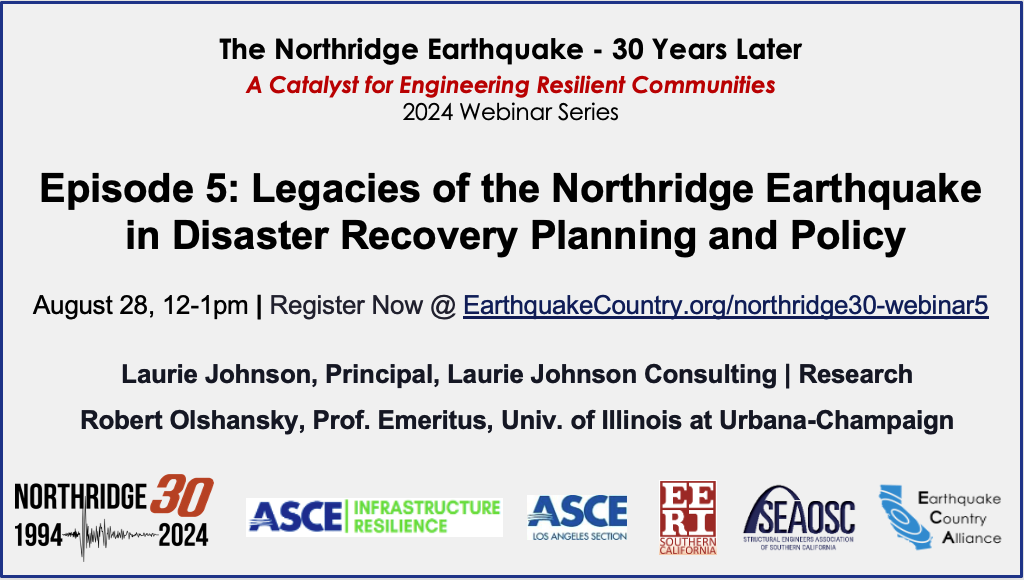
- This event has passed.
Legacies of the Northridge Earthquake in Disaster Recovery Planning and Policy
August 28, 2024 @ 12:00 pm - 1:00 pm
Free
Episode 5 of the Northridge 30th Anniversary Webinar Series:
The Northridge Earthquake – 30 Years Later – A Catalyst for Engineering Resilient Communities
Series Partners:
- American Society of Civil Engineers (ASCE) Infrastructure Resilience Division
- ASCE Los Angeles Section
- Earthquake Engineering Research Institute (EERI) Southern California Chapter
- Structural Engineers Association of Southern California (SEOASC)
- Earthquake Country Alliance (ECA), led by the Statewide California Earthquake Center
Episode 5 Overview:
The 1994 Northridge Earthquake was a milestone in U.S. disaster recovery management, firmly establishing long-term reconstruction as a significant topic of practice, and pioneering new practices subsequently used following 9/11, Hurricanes Katrina and Harvey, major wildfires, and more. In this webinar, we will look at the influences of the 1981 PEPPER – Pre-earthquake Planning for Post-earthquake Rebuilding – project in Los Angeles that attempted to use earthquake scenarios to drive pre-disaster planning for post-disaster rebuilding of a modern city; Los Angeles’ timely preparation before the Northridge Earthquake of the first known pre-disaster citywide reconstruction plan, which helped guide the city’s earthquake recovery efforts; the unprecedented Congressional appropriation of over $600 million in U.S. Housing and Urban Development (HUD) Community Development Block Grant and Affordable Housing Program (HOME) funds for locally-customized large-scale housing repair and community recovery projects; and the use of the Hollywood Redevelopment Plan as a ready-to-go blueprint for the district’s transformation and revival after Northridge.
Episode 5 Presenters:
Laurie Johnson, Principal, Laurie Johnson Consulting | Research
Laurie Johnson is an internationally recognized urban planner specializing in disaster recovery and catastrophe risk management. For over 30 years, she has combined her unique blend of professional practice and research in earth science, urban planning and public policy to help communities, the insurance industry and other organizations address the complex challenges posed by natural hazards and disasters. She founded her consultancy in 2006 and much of her recovery management and research is captured in the book she co-authored, After Great Disasters: An In-Depth Analysis of How Six Countries Managed Community Recovery. She also served as Chief Catastrophe Response and Resiliency Officer for the California Earthquake Authority and California Wildfire Fund from 2020 – 2023. Laurie chairs the Advisory Board for the Global Earthquake Model (GEM) Foundation and also serves on the Board of Trustees of Geohazards International and the Earthquakes and Megacities Initiative. She is the 2019-2020 President of the Earthquake Engineering Research Institute (EERI) and the 2024 recipient of EERI’s Alfred E. Alquist Special Recognition Medal for her extensive work and dedication in improving the seismic safety and resilience of communities around the world.
Robert Olshansky, Professor Emeritus of Urban and Regional Planning, University of Illinois at Urbana-Champaign, and Visiting Professor of City and Regional Planning at UC Berkeley
Robert Olshansky has studied recovery planning after major disasters, including ones in the U.S., Japan, China, Taiwan, India, Indonesia, New Zealand, and Haiti. He co-authored After Great Disasters: An In-depth Analysis of How Six Countries Managed Community Recovery (2017). His research has been funded by the National Science Foundation and Lincoln Institute of Land Policy, and in 2004-05 and 2012-13 he was a Visiting Professor at the Disaster Prevention Research Institute at Kyoto University. His current research focuses on post-disaster community relocation, and he has recently taught city planning studio courses on resilient rebuilding after California wildfires and adaptation to sea level rise along San Francisco Bay. He was the 2015 EERI Distinguished Lecturer, and he co-chaired EERI’s effort to develop post-earthquake reconnaissance methods focused on seismic resilience.
WEBINAR RECORDING & PRESENTATION SLIDES
Workshop Presentation Slides (PDF; some content shared live by presenters may not be not included)
|
(Click “CC” to see captions, once the video starts playing) |
ALL EPISODES:
- Episode 1: The 1994 Northridge Earthquake – Science and Engineering Aspects (Feb. 14)
- Episode 2: Insurance Issues and Impacts Following the Northridge Earthquake (April 23)
- Episode 3: 30 Years of Progress in Quantification of Seismic Hazards (June 12)
- Episode 4: An Unexpected Milestone in Real-Time Loss Estimation (July 24)
- Episode 5: Legacies of the Northridge Earthquake in Disaster Recovery Planning & Policy (Aug. 28)
- Episode 6: The Northridge Earthquake: the Catalyst for Resilience of Healthcare in California (Oct. 30)
- Episode 7: Lessons learned about business losses and economic recovery – The Northridge Earthquake as a catalyst for research and application (Nov. 13)
- Episode 8: Rethinking Communication about Seismic Risk – Linking Knowledge to Action in Innovative Ways Since the 1994 Northridge Earthquake (Dec. 18)
More episodes planned monthly through January 2025.
QUESTIONS: info@earthquakecountry.org




